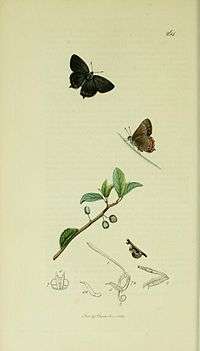Yardley Chase
| Site of Special Scientific Interest | |
 Barnstaple Wood | |
| Area of Search |
Northamptonshire Buckinghamshire |
|---|---|
| Grid reference |
SP841553 SP 857540 |
| Interest | Biological |
| Area | 353.1 hectares |
| Notification | 1984 |
| Location map | Magic Map |
Yardley Chase is a 353.1 hectare forest in Northamptonshire, with a small area in Buckinghamshire, which consists of two similar shaped forests, which are each about 2 miles (3.2 km) long, and 1 mile (1.6 km) wide, in places. The forests are about 3 miles (4.8 km) south of Yardley Hastings in Northamptonshire, and about the same distance north of Olney in Buckinghamshire.
Site of special scientific interest

The Chase is a biological Site of Special Scientific Interest.[1][2] It is home to the Black Hairstreak butterfly as well as rare dragonflies and examples of trees dating back to the English Civil War.[3]
Much of the site was originally a Norman Hunting Chase and is now woodland, pasture and parkland. More recently, military use over a large part has left a series of railway tracks, grassland glades and open pools in the forest. The value of these habitats, particularly for invertebrates, is enhanced by their long isolation from intensive agriculture and by their presence over a large area.
There is documentary evidence in the form of early maps and estate plans to indicate a long history of woodland on the site, although much of the former ancient semi-natural woodland has been replanted or modified. This has created a range of woodland types including plantations of oak, mixed broad-leaves such as ash and conifers. The integrity of the woodland blocks as a whole is essential to their nature conservation importance, but the relatively unmodified areas are of particular significance.
History
In addition to the ancient trees dating back to the civil war, Yardley Chase was also home to the oak tree which provided the inspiration for William Cowpers poem "Yardley Oak" and the area is described as having been a favourite walk of Cowper's.[4]
Military use
Yardley Chase contains some large concrete huts, about 12 metres (39 ft) long, and about 6-8m (20–25 feet) wide, which were used during World War II to store bombs. They continued in use after the war as a bulk explosives depot, until the 1970s when the Ministry of Defence shut them down when it became obvious that they would be useless in a nuclear war. The site was served by a branch of the Northampton-Bedford railway line and evidence of revetted tracks are still visible around the site which is only a few miles east of the former depot of the Northamptonshire Regiment and later Royal Pioneer Corps at Simpson Barracks in Wootton. The site also has numerous small bunkers within it and is criss-crossed by barbed wire fences once past the main perimeter. It has several tracks that lead to the various bunkers and fair amounts of military debris (mainly used pyrotechnics) scattered around it.
The Eastern munitions site is larger than its western neighbour and the bomb storage buildings, in addition to being less numerous, are also mostly surrounded by water-filled moats. The storage buildings at the western site are surrounded by earth banks. The eastern and western sites were connected by a rail track.
The site is nowadays used by Army, Navy and Air cadets, as well as the Territorial Army units for basic skills training and field-craft. This site is closed to the public. The ACF use the training area on a regular basis – along with CCF units from nearby Schools. Naval cadets from TS Invincible (Bletchley Park) also use the site for on-shore field-craft. It is also used by the air cadets from Wellingborough and Rushden for fieldcraft weekends.
A groundbreaking ceremony took place at Yardley Chase on July 11, 2013 to mark the commencement of construction work on a new £6.2 million Cadet Training Centre When complete the centre will provide lecture rooms, office spaces, dining facilities, an indoor training area and indoor shooting range, as well as accommodation for up to 185 cadets and 45 adults at one time The centre is scheduled for completion in August 2014 and will primarily be used by the Army Cadet Force, although it will also be available for use by other cadet organisations, regular and reserve forces, local businesses and community based projects When completed the existing World War Two era accommodation facilities will be demolished and the area landscaped [5]
See also
References
- ↑ "Yardley Chase citation" (PDF). Sites of Special Scientific Interest. Natural England. Retrieved 30 June 2016.
- ↑ "Map of Yardley Chase". Sites of Special Scientific Interest. Natural England. Retrieved 30 June 2016.
- ↑ "M.O.D. Opens Yardley Chase Site to Wildlife Enthusiasts"
- ↑ The Life and Works of William Cowper - Google Books
- ↑ Ground breaking ceremony marks start for new 6 million cadet trainingmcentre Northants Telegraph
Coordinates: 52°11′38″N 0°46′12″W / 52.194°N 0.770°W